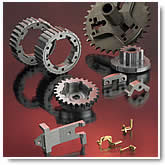 Powder
metallurgy, or PM, is a process for forming metal parts by
heating compacted metal powders to just below their
melting points. Although the process has existed for more
than 100 years, over the past quarter century it has
become widely recognized as a superior way of producing
high-quality parts for a variety of important
applications. This success is due to the advantages the
process offers over other metal forming technologies such
as forging and metal casting, advantages in material
utilization, shape complexity, near-net-shape dimensional
control, among others. These, in turn, yield benefits in
lower costs and greater versatility. Powder
metallurgy, or PM, is a process for forming metal parts by
heating compacted metal powders to just below their
melting points. Although the process has existed for more
than 100 years, over the past quarter century it has
become widely recognized as a superior way of producing
high-quality parts for a variety of important
applications. This success is due to the advantages the
process offers over other metal forming technologies such
as forging and metal casting, advantages in material
utilization, shape complexity, near-net-shape dimensional
control, among others. These, in turn, yield benefits in
lower costs and greater versatility.
The PM process provides a host of
advantages over competing metalworking technologies. These
all add up to cost effectiveness, shape and material
flexibility, application versatility, and part-to-part
uniformity for improved product quality. Advantages
of the PM Process:
- Eliminates or minimizes machining by
producing parts at, or close to, final dimensions
- Eliminates of minimizes scrap losses
by typically using more than 97% of the starting raw
material in the finished part
- Permits a wide variety of alloy
systems
- Produces good surface finishes
- Provides materials which may be heat
treated for increased strength or increased wear
resistance
- Provides controlled porosity for self
lubrication or filtration
- Facilitates manufacture of complex or
unique shapes which would be impractical or impossible
with other metalworking processes
- Is suited to moderate- to high-volume
component production requirements
- Offers long-term performance
reliability in critical applications
- Is cost effective
The PM industry is comprised of three
major segments:
- Companies that produce the powders,
lubricants, industrial gases and other raw materials
that go into making finished components
- Companies that manufacture and
provide the tooling, process equipment, and related
services used in the making of finished components
- Contract and in-house fabricators of
finished component.
Of course, the most important segment of
the industry—one not represented above—is made up of the
end users of PM parts, the designers and specifiers for
the OEMs who take advantage of PM’s superior capabilities
in a wide range of applications.
The PM process consists of mixing
elemental or alloy powders, compacting the mixture in a
die, and then sintering, or heating, the resultant shapes
in a controlled-atmosphere furnace to bond the particles
metallurgically.
C-J Transportation Services is a
licensed PM carrier and a member of APMI. You can
learn more about powdered metallurgy and APMI at the
MPIF website. |